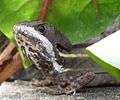Brown basilisk
| Brown Basilisk | |
|---|---|
 | |
| Striped or Brown Basilisk | |
| Scientific classification | |
| Kingdom: | Animalia |
| Phylum: | Chordata |
| Class: | Sauropsida |
| Order: | Squamata |
| Suborder: | Iguania |
| Family: | Corytophanidae |
| Genus: | Basiliscus |
| Species: | B. vittatus |
| Binomial name | |
| Basiliscus vittatus Wiegmann, 1828 | |
The brown basilisk or striped basilisk (Basiliscus vittatus; in some areas referred to as "common basilisk") is one species of basilisk lizard. They are native to Mexico, Central America and adjacent northwestern Colombia,[1][2] but have been introduced into the U.S. state of Florida as a feral species.[3]
Basilisks actually have large hind feet with flaps of skin between each toe. The fact that they move quickly across the water, aided by their web-like feet, gives them the appearance of "walking on water".
Male Brown Basilisks can reach 61 centimetres (24 in) in length and females are somewhat smaller. Their three crests are on the head, along the body and along the tail. They usually appear in brown or olive brown with black stripes. The stripes are usually only on the flanks and on the dorsal crest. They also have a white stripe, which extends from the eyes to the rear legs. The males have a larger crest than the females.
Taxonomy and etymology
The Brown Basilisk's generic name basiliscus is taken from the creature of Greek mythology made up of parts of a rooster, snake, and lion which could turn a man to stone by its gaze: the Basilisk. This name derives from the Greek basilískos (βασιλίσκος) meaning "little king". This epithet was given in Carl Linnaeus' 10th edition of Systema Naturae.
.jpg)
Smaller basilisks can run about 10-20 metres on the water without sinking. Young basilisks can usually run farther than older ones. If the animal faces danger, it starts to run very fast on the surface of a river or a lake. Then the flaps on its hind feet are opened and thus more surface area is provided for it to run on water.
They are in the same infraorder as the iguanid family. Like most reptiles, basilisks are active during the day. They have long toes and sharp claws. Most are under a foot in length, but some may grow up to two feet. Basilisks usually weigh between 200-600 grams. Their maximum lifespan is probably around 7-8 years. In the wild, most die much sooner. Females lay about 2-18 eggs, five to eight times a year. Eggs hatch after about three months and the babies weigh about 2 grams. Their outstanding camouflage allows them to remain motionless and very hard to detect.
Gallery
-

Basiliskus vittatus
-

Juvenile before developing crests
-
Basiliscus vittatus
-

-
feral Basiliscus vittatus in Florida, United States of America
References
- ↑ Kohler, G. (2008). Reptiles of Central America, 2nd edition. ISBN 978-3936180282
- ↑ Savage J. M. (2005). The Amphibians and Reptiles of Costa Rica: A herpetofauna between two continents, between two seas. ISBN 978-0226735382
- ↑ Conant, Roger; Collins, Joseph (1991). A Field Guide to Reptiles and Amphibians Eastern/Central North America. Boston, Massachusetts: Houghton Mifflin Company. ISBN 0-395-58389-6.
| Wikispecies has information related to: Basiliscus vittatus |